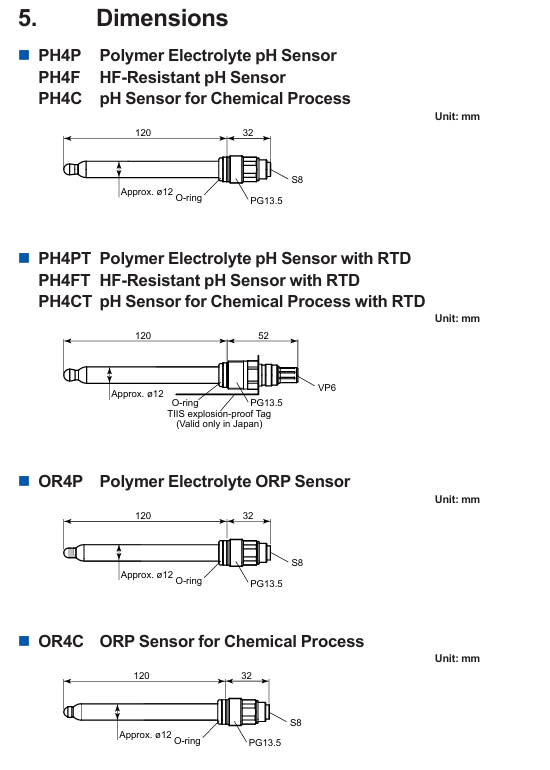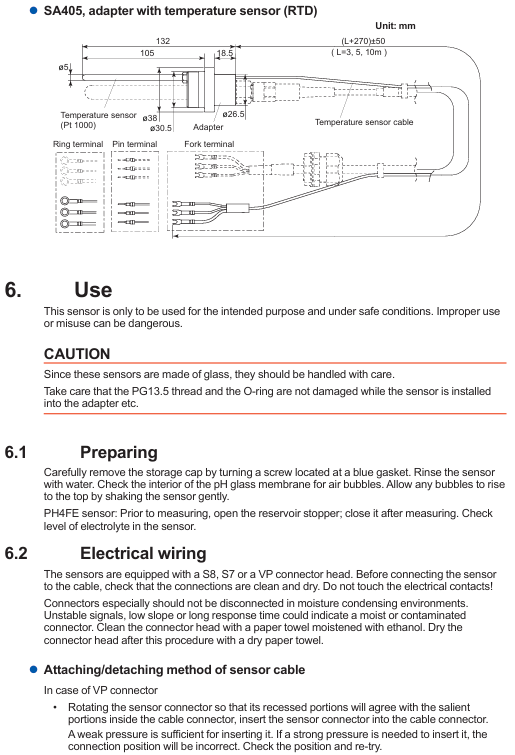How to install and wire Yokogawa PH4/OR4 series pH and ORP sensor (IM12B10B00-01EN)?

Operations and Calibration
1. Daily maintenance
(1) Electrolyte replenishment and replacement
PH4P/PH4F/OR4P (polymer/gel type): there is no need to supplement electrolyte, and the sensor is replaced as a whole after its service life expires (usually 1-2 years);
PH4C/OR4C (pressurized type): The initial internal pressure is 250 kPa, which drops to about 125 kPa after 1 year of use. If the process pressure exceeds the internal pressure and the medium infiltrates, causing the sensor to fail, it needs to be replaced in advance;
PH4FE (fermentation specific): Regularly open the electrolyte replenishment port and replenish 3M KCl-LR solution to the liquid level line to avoid dry burning.
(2) Electrode cleaning
Choose the cleaning method based on the type of medium contamination, only clean the sensor tip (to avoid damaging the cable/connector):
Inorganic dirt (scale, salt): Use a soft cloth dipped in 1-2% dilute hydrochloric acid to wipe, and then rinse with pure water;
Organic dirt (oil, biofilm): Soak in neutral detergent solution (30 minutes to 2 hours), or use protease solution (such as hydrochloric acid solution containing gastric protease) in fermentation scenarios;
ORP electrode oxidation: Use a soft cloth dipped in toothpaste (mild abrasive) to wipe the platinum wire/platinum ring to remove the oxide layer.
2. Calibration process
(1) PH sensor calibration (two-point calibration method)
Prepare buffer solution: Select two points that are close to the process pH (such as pH 4.01+6.87, or pH 6.87+9.18), with the same temperature as the process;
Clean the sensor: Rinse the sensor with pure water to absorb surface moisture (avoid dilution with buffer solution);
First point calibration: Immerse in the first buffer solution (such as pH 6.87), wait for the reading to stabilize, and then follow the transmitter (such as FLXA202) prompts to perform "zero point calibration";
Second point calibration: Rinse with pure water and immerse in a second buffer solution (such as pH 4.01), perform "slope calibration", and ensure that the slope is ≥ 96%;
Verification: After calibration, return the first buffer solution with an error of ≤ 0.02 pH. Otherwise, clean and calibrate again.
(2) ORP Sensor Calibration (Quinone Hydroquinone Standard Method)
Prepare standard solution: Dissolve 1g of quinone hydroquinone powder in 200mL of pH 7.00 buffer solution and stir until saturated;
Calibration operation: Immerse the ORP sensor in a standard solution, wait for the reading to stabilize, and then enter the theoretical value according to the transmitter prompt (ORP=88 mV, rH=23.6 at pH 7);
Error allowance: Calibration error ≤ ± 10 mV. If it exceeds the tolerance, the platinum electrode needs to be cleaned and recalibrated.
3. Storage and regeneration
Short term storage (<1 month): Put on a storage cap and inject 1.5-2mL of 3.3M KCl solution to avoid electrode drying;
Long term storage (>1 month): It is recommended to replace the storage solution every 3 months to prevent electrolyte deterioration;
Sensor regeneration: If the sensor is dry or the response slows down, the pH sensor can be soaked in 0.1M NaOH (10 minutes) → 0.1M HCl (10 minutes) → 3.3M KCl (15 minutes); Clean the platinum surface of ORP sensor with abrasive.

- EMERSON
- Honeywell
- CTI
- Rolls-Royce
- General Electric
- Woodward
- Yaskawa
- xYCOM
- Motorola
- Siemens
- Rockwell
- ABB
- B&R
- HIMA
- Construction site
- electricity
- Automobile market
- PLC
- DCS
- Motor drivers
- VSD
- Implications
- cement
- CO2
- CEM
- methane
- Artificial intelligence
- Titanic
- Solar energy
- Hydrogen fuel cell
- Hydrogen and fuel cells
- Hydrogen and oxygen fuel cells
- tyre
- Chemical fiber
- dynamo
- corpuscle
- Pulp and paper
- printing
- fossil
- FANUC
- Food and beverage
- Life science
- Sewage treatment
- Personal care
- electricity
- boats
- infrastructure
- Automobile industry
- metallurgy
- Nuclear power generation
- Geothermal power generation
- Water and wastewater
- Infrastructure construction
- Mine hazard
- steel
- papermaking
- Natural gas industry
- Infrastructure construction
- Power and energy
- Rubber and plastic
- Renewable energy
- pharmacy
- mining
- Plastic industry
- Schneider
- Kongsberg
- NI
- Wind energy
- International petroleum
- International new energy network
- gas
- WATLOW
- ProSoft
- SEW
- wind
- ADVANCED
- Reliance
- YOKOGAWA
- TRICONEX
- FOXBORO
- METSO
- MAN
- Advantest
- ADVANCED
- ALSTOM
- Control Wave
- AB
- AMAT
- STUDER
- KONGSBERG
- MOTOROLA
- DANAHER MOTION
- Bently
- Galil
- EATON
- MOLEX
- Triconex
- DEIF
- B&W
- ZYGO
- Aerotech
- DANFOSS
- KOLLMORGEN
- Beijer
- Endress+Hauser
- MOOG
- KB
- Moxa
- Rexroth


Email:wang@kongjiangauto.com






















































































































